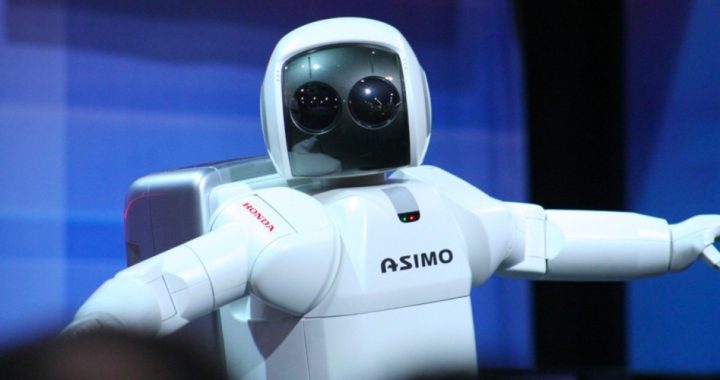
More than two dozen massive bright red robots move 20-foot-long shipping containers at the Los Angeles terminal developed by TraPac, cutting costs by between an estimated 30 and 50 percent. A new terminal, being built at the Port of Long Beach, will be able to handle nearly half of that port’s entire volume, moving and stacking more than three million of those shipping containers every year.
But the Port of Rotterdam in the Netherlands has more automated delivery terminals than the entire United States, thanks to delays by Luddite unions in America determined to keep the robotic revolution from happening. According to Steve Sugarman of the Pacific Maritime Association, which represents 72 cargo carriers and terminal operators on the U.S. West Coast, shippers still have to rely on chalkboards (big blackboards with white chalk writing tools dating back to the 1960s) because the unions have opposed the introduction of computers. Said Sugarman, “It slows down the process.”
The robotics revolution, thanks to Moore’s Law (how overall processing power for computers will double every two years) and the consequent dramatic lowering of the cost of information, is sweeping across the world, whether unions like it or not. High-tech software is replacing stock traders, steel workers, and front loader drivers — making work places not only safer but more efficient. In some cases robots are doing the jobs of 10 workers.
Restaurants are leading the way, with Olive Garden, White Castle, Taco Bell, Applebee’s, Panera Bread, Burger King, Subway, Arby’s, and Chili’s already using computer tablets that allow customers not only to order but to pay their bill. The math is inevitable. Startup company E La Carte makes a tablet called Presto that it leases for $100 a month. If a restaurant serves meals 12 to 15 hours a day, seven days a week, it would cost the restaurant less than 50 cents per hour per table, which would be more than offset by the reduction in the number of servers. And unlike a server, the tablet needs no training, takes no restroom breaks, doesn’t get pregnant, isn’t required to take vacations, doesn’t walk off the job for a smoke break, and can’t accidentally offend with small talk.
At Lowes Home Improvement stores customers are being greeted by OSHbot, which speaks two languages, answers questions, and guides customers to items in the store. It provides information about the item, and when its battery runs low, it runs itself over to the recharging station.
Target recently announced its plans to start replacing team members with robots called Techstar, an automated system taking advantage of the latest technology. Within two years it will have up and running a “concept store” that will have robots working alongside those team members who will continue to work there.
In Sasebo in southern Japan a new hotel staffed by 10 humanoid robots will check customers in, carry their luggage, and clean up their rooms after they check out. It’s called the Henna Hotel: in Japanese, that’s “Weird Hotel.”
What isn’t weird is the number of jobs robots are doing — jobs that used to be done by pastry chefs, typists, paralegals, math teachers, and anesthesiologists. Robots can now write music, diagnose diseases, and trade stocks. If you’re a writer, consider this:
Things looked bleak for the Angels when they trailed by two runs in the ninth inning, but Los Angeles recovered thanks to a key single from Vladimir Guerrero to pull out a 7-6 victory of the Boston Red Sox at Fenway Park on Sunday.
This was written by a robot.
What about those being displaced by a robot? According to a recent study by CareerBuilders, a U.S. online job site, more than half of the employers surveyed were offering jobs but were unable to find qualified people to take them. Seventy-one percent had trouble finding information technology specialists, 70 percent couldn’t find engineers, 66 percent couldn’t find qualified managers, 56 perceent couldn’t find takers in the health-care industry while more than half couldn’t find takers for open positions for financial operations. This was confirmed by the National Federation of Independent Business (NFIB): nearly half of small or medium-sized employers said they couldn’t find “qualified applicants” for their job openings.
Other jobs threatened by the new robotic technology include telemarketers, legal secretaries, watch repairers, and even models displaying clothing, underwear, and shoes.
When Hillary Clinton expressed concerns that robots were “raising hard questions” about “workplace protections” and “what a good job would look like in the future,” Emily Zanotti, writing an article in The American Spectator titled “Hillary Clinton, Old Person, Does Not Like This Newfangled Uber App,” wondered if Clinton herself was obsolete:
Today, Hillary spent half her speech railing on the Wall Street banks that make up a significant part of her donor base, and the other half complaining about these young whippersnappers and their newfangled smartphones with the texting and the Facebooking and the Ubering.
I mean, who do they think they are, circumventing an antiquated and burdensome, union-driven transportation boondoggle with ingenuity and common sense and a cooperative network that allows individuals to purchase products on a free market that they themselves police?
A graduate of an Ivy League school and a former investment advisor, Bob is a regular contributor to The New American magazine and blogs frequently at LightFromTheRight.com, primarily on economics and politics. He can be reached at [email protected].
Related articles:
Robots Are Taking Over Agriculture
Robots Transforming China, Causing Heartburn at World Economic Forum



